It’s an unfortunate fact that travelling is bad for the environment. However by making small, low effort changes to how and what we do when we travel, we can attempt to counteract and minimise our negative impact on the planet.
If you want some ideas about what you can do, here are just five things that I am doing at home and abroad in an attempt to be a more eco-friendly traveller. They’re effortless and easy to apply to your lifestyle.
I hope you consider adopting some, (if not all) of these easy eco travel tips!
*This post may contain affiliate links meaning should you purchase a product via this link, I’ll earn a small commission at no extra cost to you. See my privacy and disclosure policy for more.*
Download Ecosia As your Search Engine
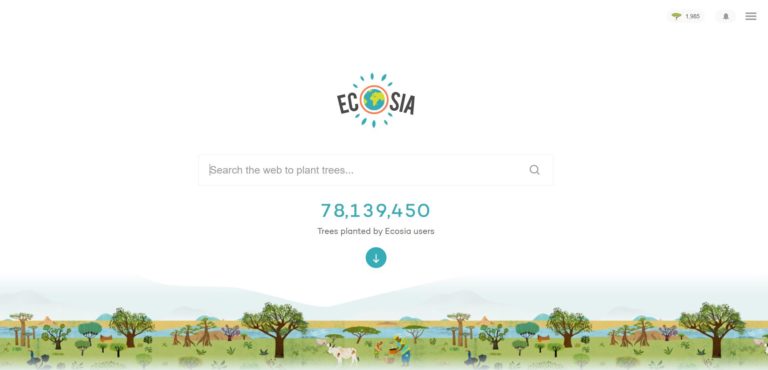
Counteracting your travel impact on the world can actually begin at home, before you even set foot on a plane, train or boat!
I have downloaded Ecosia, an awesome search engine that donates money to plant trees each and every time you search for something on the internet.
Ecosia literally works as your homepage in place of Google. So when you’re researching or booking your trip, instead of adding profits to a tech giant, you are donating (and the best bit of all – without even realising) to a charity!
I love the little feature at the top which shows you a little icon of how many trees you have ‘planted’. It really makes you feel like you’re making a little difference. To date, I have contributed to the planting of nearly 2,000 trees!
Ecosia has all the same features and search power as Google and in fact I actually prefer it. When you go onto ‘maps’ for example, you can choose whether you go on Bing or Google Maps, giving you that little bit more choice.
It’s such a simple and brainless way to counteract carbon emissions. If there is just one thing you need to do today, it’s installing Ecosia on your PC or laptop!
Use a LifeStraw Go Water Bottle
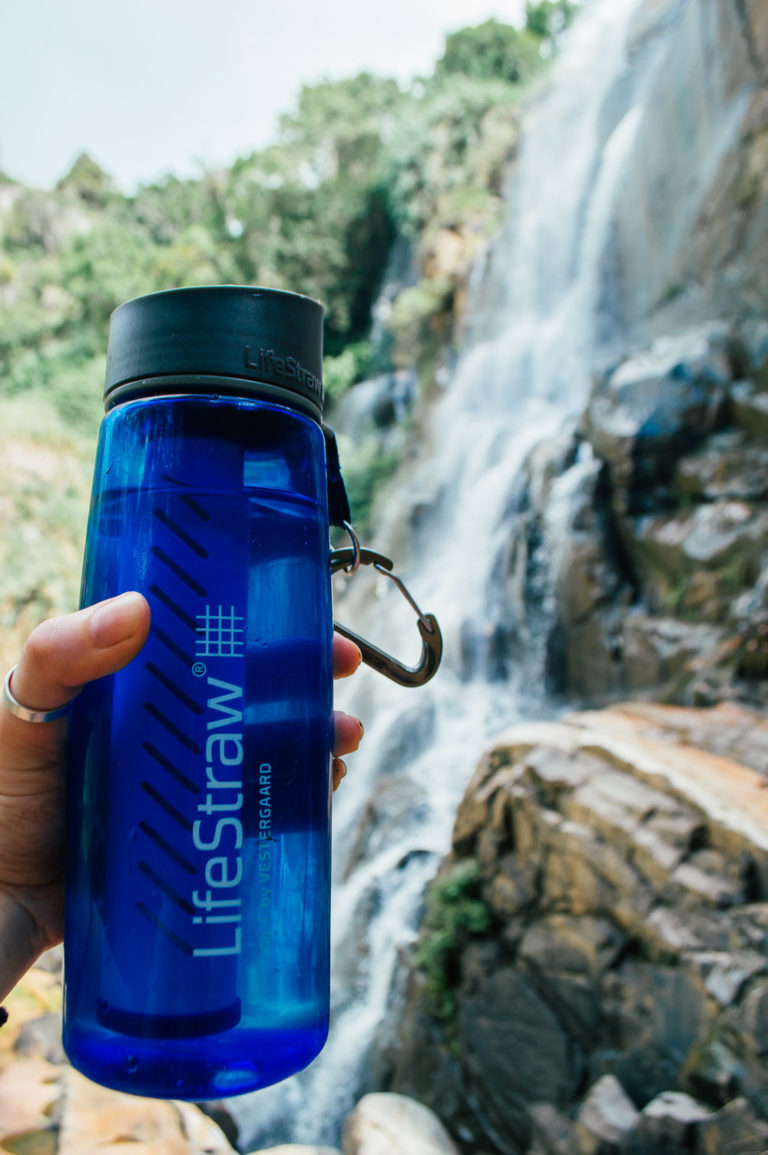
The LifeStraw Go is probably my favourite, most useful travel purchase of all time. I honestly don’t know how I coped for so many years without it!
The LifeStraw is a patented micro-filtration system that kills 99.9% of bacteria, meaning you can drink literally any quality of water (so long as it isn’t saltwater). Yup – even toilet water if you so desired…
It has literally been a lifesaver at times when I have been hiking and run out of drinking water. Though most commonly after a night out when I have unbearable thirst in a country with unsafe tap water and no shops around!
Although it is unfortunately made from plastic (LifeStraw – please make a metal one!) taking this travelling has drastically cut down on the amount of single use plastic bottles I am purchasing. I’m not only using less plastic when I travel, I’m also saving myself money too. Bottled water definitely adds up, even in the cheapest of countries!
LifeStraw have a ‘giveback’ programme meaning with every purchase, they either donate a LifeStraw product to a third world country to provide safe drinking water, or your purchase helps to fund the many humanitarian projects they are leading across the world. It’s refreshing to see a company with such socially conscious values at their core.
Oh – and the taste of cold, fresh, natural water from a waterfall or stream is heavenly! You can purchase a Lifestraw Go bottle here.
Read this if you’re interested in finding out about some more eco-friendly travel products I would recommend.
Use Eco/Reef-Friendly Sunscreen
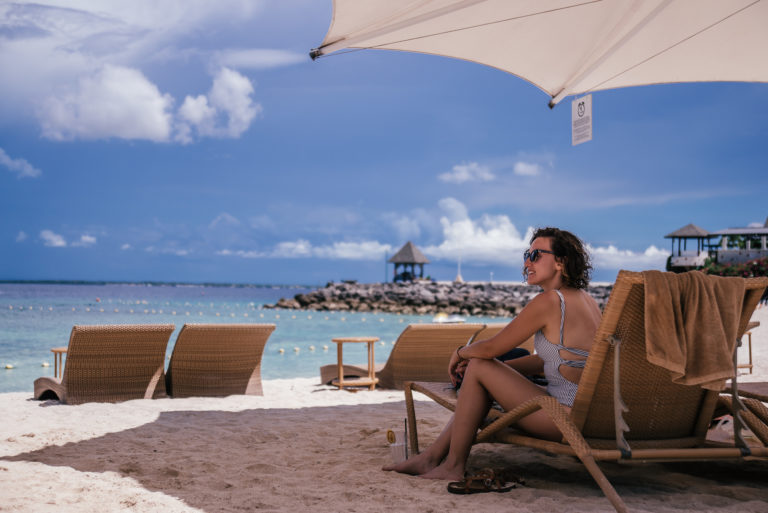
I cringe when I see people smothering themselves in sunscreen and then jumping into the ocean to swim or even worse, to dive or snorkel.
Sunscreen is super toxic and I don’t think many people realise how harmful it is for sea organisms, especially coral which is already facing bleaching from rising sea temperatures.
Wearing a t-shirt to minimise the amount of skin exposed to the sun when in the water is one way to reduce sunscreen use. But another way is to invest in some eco-friendly sunscreen. They are often made with zinc oxide and other natural ingredients so are way better for your skin too.

To cut down on my plastic usage, I usually try and go for a sunscreen in a mental tin or bamboo pot.
‘All Good Sunscreen Butter‘ has been my favourite to date as it does not leave your skin all white and sticky like most eco ones do.
Be aware of natural plant oils such as lavender and eucalyptus though. These oils can be found in many organic sunscreens but they are actually toxic to reef organisms as well.
Just because it’s ‘natural’ or ‘organic’, it doesn’t necessarily mean it’s 100% reef safe so look out for this, or a stamp of approval on the bottle from a marine organisation before you buy.
Eat Vegetarian or Vegan Whilst Travelling

Meat (especially red meat) is one of the largest contributors of greenhouse gases into the environment. The most common misconception is that it’s just the large amount of methane the animals (especially cows) release – but this is not wholly true.
It is actually the devastating deforestation that is occurring to both graze the vast amount of animals we are consuming and also to grow their food. Trees are literally being ripped down across the world to satisfy billions of people’s unhealthy diets.
I cook vegetarian food at home and only eat meat when I am out, but in all honesty I struggle. However when I travel, I find I have more time to really invest in eating a completely vegetarian or sometimes vegan diet.
It is especially easy to do this in vegetarian-friendly countries such as Sri Lanka or Malaysia, where a lot of the population don’t eat meat anyway (mainly for religious or hygiene purposes).
Avoiding meat travelling is also a great way to avoid getting sick and try some really flavoursome new food. When I was in Sri Lanka, I met quite a few people who got food poisoning and I was totally fine for my whole 3 week trip as I didn’t touch meat once.
This is just one small way you can reduce your carbon footprint abroad – even if you struggle to do it at home.
Pay to Offset Your Carbon Emission

According to Qantas and Jetstar, only one in ten passengers will pay to counteract their flight’s carbon emissions. I have to admit that only until recently I was also one of the 9 who didn’t.
Always the cynic, I have never trusted that airlines firstly work it out accurately, let alone give all the money they say they do to an environmental charity. However especially with a recent shift in the general public’s consciousness of this topic, airlines are becoming a lot more transparent about the carbon emissions flights produce.
It’s in the airlines best interest to encourage carbon neutral flying and they do actually donate your contribution to minimise your greenhouse gas impact.
Again, it’s just an easy extra click at the checkout. Although it will make your ticket a tiny bit more expensive, no additional effort is needed at all.
These eco-friendly travel tips require minimal effort and can be enforced by anyone and everyone. Are there any more eco-friendly travel tips you would add to this list? Let me know in the comments below!
Going Travelling Soon? Don’t forget these essentials!
Book your accommodation through Booking.com or Hotels.com.
To cover yourself for any unplanned situations, I use and would recommend World Nomads travel insurance.
To search and compare the best group tours and activities worldwide (with up to 50% off), use TourRadar.
For some travel inspiration for your next trip, how about Lonely Planet’s top 500 places to see… ranked?
Don’t forget to check the government visa entry requirements for the passport you are travelling with.
PIN ME FOR LATER:
*This post may contain affiliate links meaning should you purchase a product via this link, I’ll earn a small commission at no extra cost to you. These are still products I use or believe in regardless. See my privacy and disclosure policy for more.*


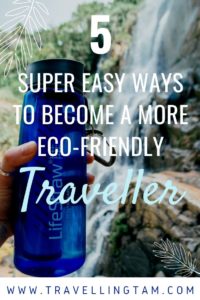
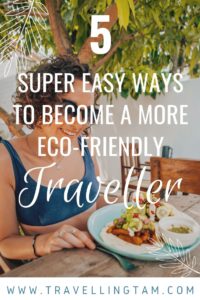
These are all great tips! And so easy to implement. I feel like these are the types of changes that would inspire me to implement even greater lifestyle changes to continue making an impact. Thank you!
Yes to all of this! Love it. I’m trying to be more conscious of these things as I travel. I’m already vegetarian, have been for 13 years so that’s one thing I’m doing well. I try to remember to carry my bottle with me but I think everyone can always do more
Great tips! Does that sunscreen leave a white residue behind on the skin?
Great tips! I will have to download the Ecosia browser, that sounds so cool-and a great and simple way to help. THanks for sharing
Great eco-friendly tips when traveling! I’ve never heard of Ecosia but will have to check it out!
Some really great tips. Downloading Ecosia as we speak.
Really useful guide, thank you! First time hearing of Ecosia but will have to download it!
I think the mentality is that it’s hard to travel and stay eco friendly, but you prove them wrong with this post. It’s just small, simple things we do (or don’t) that have an impact. I also travel with totes so when I pick up groceries on my travels, I’m not generating plastic waste. Great post!
Very smart post! I do practice as much vegan as possible…keep up the posting!
I’m currently working on the eating less meat one – definitely have cut back a lot! These are some good things to keep in mind while traveling. I’ve also decided to buy mostly second hand as well.
Great post – these are tips which are really easy to take up. And I consider myself someone who is hot on sustainability, but I’d never heard of Ecosia – definitely going to download it.
Such a fab and practical guide, I’m definitely looking at getting a Lifestraw and investing in coral friendly sunscreen for next year!